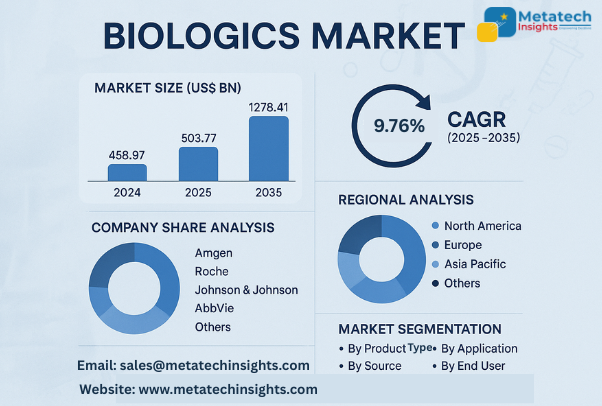Global Biologics Market to Hit USD 1278.41 Bn by 2035 | CAGR 9.76%
22 Aug 2025 | Report ID: MI3390 | Industry: Healthcare | Pages: 210 | Forecast Year: 2025-2035

Read more about this report- Global Biologics Market to Hit USD 1278.41 Bn by 2035 | CAGR 9.76%
The Biologics Market is valued at USD 458.97 billion in 2024.
The Biologics Market will achieve USD 1278.41 billion by 2035 through a projected 9.76% CAGR from 2025 to 2035.
The rising incidences of aging-related chronic illnesses, autoimmune diseases, and cancer are fueling the need for biologics across the globe. The increased awareness of the high efficacy, targeted treatment, and safety profile of biologics against conventional therapies is stimulating their introduction. Along the same lines, biologics are favored since they offer personalized treatment, have fewer side effects, and offer an improved quality of life for patients. Growth in this market is also being driven by innovation in both formulation and delivery systems and therapeutic targets.
The market may also be segmented according to the product type into monoclonal antibodies, therapeutic proteins, vaccines, and cell therapies, among others. Monoclonal antibodies will continue to lead the market, as these are used extensively in the oncology and autoimmune field, with new segments, including cell and gene therapies, experiencing rapid growth as a result of ongoing innovation in the field of precision medicine and cell-/gene-based therapies.
Depending on the application, biologics are applied in oncology, autoimmune and inflammatory diseases, infectious diseases, and cardiovascular conditions, among others. The largest segment remains oncology, triggered by the elevated levels of cancer and the increasing popularity of selective treatments. Autoimmune and inflammatory conditions also display solid growth based on the rising acceptance of biologics, which offer superior management of the disease with fewer side effects as compared to conventional methods. Source-wise, the biologics are prepared by means of recombinant DNA, cell culture, and microbial fermentation. The most common one is the recombinant DNA because it is scalable and serves to generate very precise therapeutic proteins. Microbial and cell-based sources are being innovated to produce them cost-effectively and at new treatment possibilities.
In terms of end-users, the market is also divided into segments, namely hospitals, specialty clinics, research & diagnostic centers, and home care environments. Hospitals and specialty care outpatient clinics are still the most important end-users because they are required to provide complex medical therapies and monitor patients continuously. Research & diagnostic centers help expand their current business by conducting clinical trials and drug development pipelines.
According to the research, the key dynamic trends influencing the biopharmaceuticals market include the growth in R&D expenditure, the presence of regulatory support for the advanced therapies, the growth in patient awareness, and the uptake of healthcare infrastructure expansion. Drug formulation and delivery method optimization and biosimilar creation are the targeted areas of interest, leading to the active development of the market. Also, there is growth through the adoption of digital health technologies, patient-centered services, and environmentally sustainable manufacturing practices.
Geographically, the biologics market includes North America, Europe, Asia-Pacific, Latin America, and the Middle East & Africa. North America is on top because of a lot of healthcare spending, developed medical infrastructure, and an early adoption of novel treatments. Europe is close on its heels, as there is a robust appetite for biologics in oncology and diseases of autoimmunity. In terms of the highest and most rapid development, the Asia-Pacific region is expected to experience most of this growth as a result of the high rise in awareness of health and the development of new biopharmaceutical products and treatments being available to control the health of the population.
Among other competitors in the market, Amgen, Roche, and Johnson & Johnson, among others, are major players. Such firms are making huge bets on product innovation, acquisition-driven strategies, and innovation within new markets. Some of the major growth areas are the development of a new generation of biologics, biosimilars, diversified portfolios of therapeutics, digital marketing programs, and international distribution channels, so that leading the trend of this shifting market can be established.
Maximize your value and knowledge with our 5 Reports-in-1 Bundle - over 40% off!
Our analysts are ready to help you immediately.
